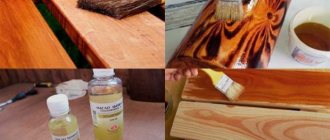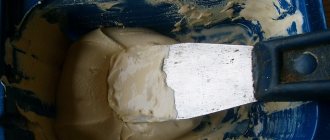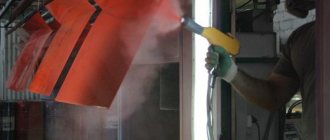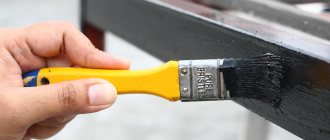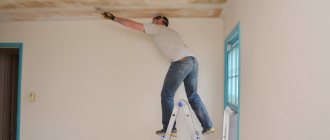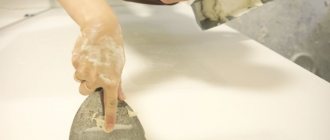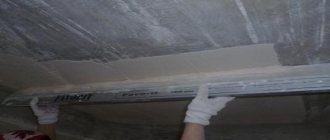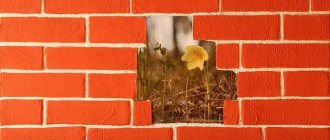Treating wood with oil is a traditional way of caring for wooden surfaces. Oil compositions ensure the safety of the material for many years of operation, impart hydrophobic properties to the surface and protect against the development of all kinds of unfavorable processes. However, oil treatment is not as simple an operation as it seems at first glance. Applying oil products to wood has its own characteristics, without knowing which you can get a completely opposite result and ruin the coating. In this review we will focus on how to apply oil to wood, what subtleties and nuances exist in this work.
How to choose impregnation oil
The most common oils used for wood processing:
- tung;
- teak;
- tar;
- flaxseed
Each of the presented oils has its own characteristics; a brief overview of all products is given in the article “Characteristics and classification of oil impregnations for a wooden house.” Here we will focus on the criteria for choosing oil, and also consider what is best to coat the wood in a given case.
- The most popular of the products presented is flaxseed oil. It is universal and can be used both outside and inside the house. Linen impregnation is excellent for damp rooms, because... has good hydrophobic properties. The oil takes a long time to dry, up to three weeks; to speed up the process, wax is added to it. At low temperatures, the oil becomes hard, which complicates the treatment of external surfaces.
- Tar oil is ideal for treating the facades of log and timber houses. It perfectly withstands any weather conditions and is resistant to sub-zero temperatures. In addition, it is one of the best natural antiseptics and protects external surfaces from rotting. It is not advisable to use tar impregnation indoors, since it contains turpentine.
- Teak oil is suitable for impregnation of any surfaces; it provides effective protection from moisture, UV radiation and other adverse factors. This product is also used to coat expensive wood species.
- Tung oil is intended for treating interior surfaces. It differs from other types of oils in its faster drying rate. The oil creates a durable film that has a high water-repellent effect. Very often used for restoration of antiques.
All of the above oils are natural products; their use does not cause any adverse effects for humans. Today, mineral oil, which is based on petroleum products, is often used for surface treatment.
Manufacturers claim that synthetics are safe and can be used to treat interior spaces. However, this is not true; synthetic additives are released into the atmosphere and are harmful to health. Therefore, the use of artificial oils is permissible only externally, and only if the product has been deeply cleaned.
Tung oil is a material obtained by pressing the seeds of the tung tree nut.
The oil belongs to the group of quick-drying oils along with flaxseed, safflower, poppy seed and soybean. However, it dries faster than the above listed oils (very controversial). When applied, it gives the surface hardness, a high level of water resistance, and the product does not darken over time as after coating with linseed oil. However, this is not a colorless finish; the oil has a faint golden tint. Tung oil is sometimes called "Chinese wood oil". This oil has been used to impregnate wood for hundreds of years in China in the construction industry, in shipbuilding to protect the hulls of wooden ships.
Selecting oil according to wood type
When choosing a specific oil, you should always consider the wood species. To determine how an oil-coated surface will look, it is necessary to test on a small area.
- Conifers contain resins that prevent oil from penetrating into the structure, so they do not require oil impregnation. To protect the surface, if absolutely necessary, you can use thick compounds in one layer or treat wood of this species by waxing.
- For low-density wood, alder and linden, it is also better to use thick, saturated impregnations. The use of fluid compositions is undesirable, since with deep penetration, they remain inside in a liquid state.
- Beech and birch are characterized by high density, and therefore they are first treated with liquid compounds, and then with thicker ones, which have a high degree of solids, and wax.
How can you dilute the oil?
To improve one or another characteristic of the oil, various components are added to it. For example, to increase the absorption of tung oil, it is diluted by 40% with white spirit.
To increase the drying speed of linseed oil, it is mixed with turpentine in a ratio (70:30) and then heated. However, it must be taken into account that turpentine is toxic and has a pungent odor, so this composition can only be used for external treatment. Tar is less toxic and can also be added to oil to speed up the drying process.
To impregnate wooden surfaces inside the house, wax is added to the oil. It increases the water-repellent and antistatic properties of the surface and accelerates the hardening process of the oil composition.
If you want to change the color of the wood or get a more saturated shade, you can tint the oil using pigments. Tinting allows you to improve the appearance of a wooden house by painting it in the natural tones of more valuable wood species.
If you want to give your house a color unnatural for wood (red, green, blue), add oil paints or casein-oil tempera to the impregnation. You can also dilute the oil with gouache, but in this case mixing must be done while hot to remove excess liquid from the paint.
When choosing a contractor, be sure to check the information about it. Study reviews, reputation and portfolio. It is also important to familiarize yourself with the contract agreement . Agreeing on the conditions, deadlines for completing work under a contract and estimates is one of the most important “preparatory” stages. Often mistakes made at this stage lead to the greatest losses.
What are the popular models?
Product classification is carried out according to basic technical parameters: viscosity, density, type of volatile compounds, amount of dry residue, and the presence of special additives. The following types of oils are considered widespread and in demand:
| Types of coating | Description |
| Degtyarnoe | The main difference from other products is the strongest antiseptic abilities. Refers to natural ingredients. The composition contains turpentine, wood resins and linseed oil. Area of application: processing of piers, yachts, boats and other watercraft. Ideal for impregnating log buildings, gazebos and garden furniture. There is no need for thinner. |
| Tung | It is extremely popular among those who need to protect wooden structures from excessive humidity. Suitable for interior work. Prevents the appearance of rot, mold, mildew, and insects. The scope of application is varied. It opens dishes and furniture, walls and ceilings. The penetration time into the upper layers of logs is minimal. Helps improve structure. To prevent thickening and increased consumption, experts recommend manipulating it at temperatures above 15 degrees Celsius. |
| Linen | The best natural product. Inexpensive and high quality. It has excellent protective characteristics and waterproofing properties. Can be used for interior and exterior work. Popular models are widely used for impregnation of facades, exterior and interior items, and furniture. Penetrates into any hard-to-reach areas, including microcracks. The result is a durable, waterproof film. |
| Vaseline | Belongs to the organic category. The main components are saturated paraffinic carbon compounds. A good choice for covering any wooden products. It is very popular due to its lack of color and odor. Emphasizes the natural beauty of structures. Upon completion of drying, a thin film is formed on the surface, characterized by moisture-repellent qualities. The result is the impossibility of deformation and cracking. |
| Sunflower | Applicable in exceptional cases. The amount of polyunsaturated components is at a minimum level, which does not allow you to fully obtain a decent enveloping effect. Over time, the wood may begin to rot and damaged areas will appear. There is also no polymerization, which prevents it from drying completely. |
| Teak | It is considered a universal and environmentally friendly product. The main components are purified turpentine, linseed oil and tung oil. Used for external and internal work. Often purchased for impregnation of valuable wood species. Breeding is strictly prohibited. You can purchase it at specialized retail outlets or order it online in an online store. |
| Danish | It has nothing to do with Denmark. Special development. A variety of natural resins and components of plant origin are used in production. Allows you to create natural beauty matte finishes. Suitable for use inside and outside. Can be used either independently or as an additional impregnation. Ideally emphasizes the natural beauty of the timber. No shine appears on the surface. |
| Toning | In addition to its protective functions, it helps create a beautiful shade on the surface. Can be used on almost all types of wood. The composition contains natural pigments. The basis is oxidized vegetable fats. Able to prevent damage to the material from fungus and mold, dust and pollution, rotting and getting wet, harmful insects, drying out and fading, and the appearance of microcracks. Can be used for impregnation of: • floors; • stairs; • furniture; • beams; • linings; • external finishing of buildings; • parquets. |
| Mineral | Used in industry for impregnation of deeply cleaned surfaces. It is practically not used in everyday life, except sometimes for outdoor work. To treat external decorative products and facades of non-residential buildings, a mixture of vegetable and mineral oils is used. |
| Colored and white | Area of application: treatment of structures damaged by mold or insects. The white substance is used for tinting if there is a need to lighten surfaces. On store shelves you can find products from domestic and foreign manufacturers. The main purpose is to paint furniture, decorative elements, and walls. Completely safe. The composition contains no toxic elements. Colored models give the logs the desired shade. They can be used to paint lining, sawn boards, planed logs. |
Oil application technologies
There are three ways to paint wood with oil:
- Vacuum impregnation. This technique is usually used in industrial settings. Such processing requires special equipment, so it is impossible to cover the surface using this technology yourself.
- Soaking. The method involves placing the wood in heated oil, letting it sit for a certain amount of time, and then drying it. Only small wooden products can be painted in this way.
- Layer coating. This technology is the most common. It is used for processing wooden surfaces of various sizes. This method is discussed in detail below.
Preparatory work
Properly preparing the surface is 80% of success in this job. The oil is absorbed very strongly and it is impossible to hide defects under it. Any abrasions, scratches, or unevenness will remain noticeable after applying the oil. Therefore, the main task here is to bring the surface to an ideal state.
It is quite difficult to do this manually; it is advisable to use professional equipment for this - grinding machines, polishing pads. If there are no special tools, you can do the work yourself, but of course, the appearance of the surface will be far from ideal.
So what you need to do:
- If you need to treat an old log house with oil, first of all, remove the previous coating. Paint or varnish is removed with a wire brush. This must be done very carefully so as not to damage the wood itself. If you can’t clean off the coating this way, you can heat it with a hair dryer; when the paint bubbles, you can remove it with a spatula.
- Then you need to carefully sand the wood. Professionals perform this operation using a grinder with wheels of different grain sizes, which are selected based on the condition of the surface. For rough cleaning use nozzles No. 40-80, for medium - No. 100-120, for polishing - No. 150-180. If there are no machines, you can sand by hand with sandpaper of different fractions.
- Before final polishing, all cracks and cracks must be sealed. It is necessary to putty with putty to match the color of the wood so that the patches remain invisible after applying the oil.
- After completing the preparatory work, all dust must be removed using a construction vacuum cleaner. The remaining dust will also be visible after applying the oil, so do this work as carefully as possible.
Oil application instructions
Treatment of internal surfaces
The oil can be applied cold or hot.
Application rules are the same for both options. The difference is in the oil impregnation temperature. In the first case, use oil at room temperature, in the second, the composition is heated to a temperature of 80 degrees before use. It is also necessary to warm up the surface itself with a special thermal pad, since it will not be possible to saturate cold wood with hot oil; the product will not be able to be absorbed and will remain on the surface. Regardless of the chosen method, you need to paint wood with oil in stages:
- First, the first layer of impregnation is applied. The oil is applied with a brush or cotton cloth in a thin layer and distributed evenly over the surface.
- Excess oil must be removed immediately; if this is not done, the impregnation will dry out and form a crust, which will then be very difficult to remove. To remove excess oil, you need to wipe the area with a dry cloth. You need to rub in the impregnation until the rag collects the oil. If the oil is not absorbed and is lying on the surface of the floor, you can take a rubber spatula and use it to scrape the excess into puddles, and then collect it with a rag.
- Next, the surface is polished with a soft cloth. After this, wipe all wet areas dry with a cotton rag.
- With the cold processing method, the application of the second layer begins no earlier than 5 hours; in some cases it is necessary to wait up to 12 hours. It depends on the type of oil. The second treatment with hot oil can be done after 2-2.5 hours, because it dries much faster.
- Repeated processing is carried out similarly to the first, each layer must be sanded. The number of layers depends on the condition of the surface, wood species and type of oil. Usually 2-3 layers of treatment are enough.
It takes two to three weeks for the surface to completely dry; the exact period depends on the combination of the factors listed above.
Exterior treatment of the house
Applying oil to the facade of a house made of timber and logs should be done in warm sunny weather.
It is advisable to prime the surface before doing this. Let's take linseed oil as an example. If the processing is carried out with flax oil, it must first be cleared of impurities, since under the influence of solar radiation the flax impregnation turns yellow. Methods for purifying oil:
- Using regular saline solution. To achieve a good result, the oil must be washed at least 5-7 times.
- Mix the oil with lead salt and heat the composition to 60 degrees.
- Adding ethanol.
- Photooxidation. The oil is boiled with water, filtered and kept in the light.
Impregnation application process:
- We remove the old coating.
- We polish the surface.
- We remove dust with a vacuum cleaner.
- Using a brush with soft bristles, apply the first layer of oil-turpentine impregnation.
- After drying, sand the surface and apply oil again.
- After final drying, we process the wood a third time.
Rating of premium wood oils
Osmo Anti-Rutsch Terrassen-Öl with anti-slip effect
The first place in our rating is occupied by a quality product from the famous German concern Osmo. An excellent option under 5,000 rubles, which will give the surface a matte color and silkiness. It can be used as a finishing coating when treating a terrace or used as an impregnation, applied to the board in two layers. The material is perfectly absorbed and creates a layer that protects the board from moisture. According to users, droplets of water that simply collect on the surface of the treated structure deserve special attention. If there is a slope, the droplets will roll down. This type of substance will protect products from the growth of blue stains, fungus and mold.
The average price for 0.75 l is 4485 rubles.
Osmo Anti-Rutsch Terrassen-Öl with anti-slip effect
Advantages:
- presence of anti-slip effect;
- German quality;
- time-tested brand;
- water-repellent effect;
- minimum consumption;
- different packaging.
Flaws:
- high price.
SAICOS Holz-Spezialol
A product from an equally famous German manufacturer. The substance is used to treat decking boards. Helps create a pleasant tone and a silky surface. It can also be used to refine wooden products, including furniture. The composition will protect structures from excess moisture and ultraviolet rays. Recognized as completely environmentally friendly. No crust is formed during the application process. At the same time, the pores of the wood remain open. The substance penetrates deeply into the material and does not begin to peel off over time. For application you will need a sprayer and a small amount of solvent. The optimal nozzle opening is 1-1.8 mm. Pressure indicator 1.5-2.5 Bar. No tinting required.
You can purchase a 1 liter container for RUB 2,960.
SAICOS Holz-Spezialol
Advantages:
- each type of wood has its own composition, the differences lie in the codes specified by the manufacturer;
- wide range of products;
- the tree breathes;
- dirt-repellent properties;
- economical consumption.
Flaws:
- If the coating is not pre-treated, it will acquire a grayish tint.
Berger OutdoorOil
This product from a German manufacturer is intended for processing structures that are located outdoors. The shelf life is 2 years, which will allow the buyer to wait for a profitable promotion and purchase the product for later use. The minimum container volume is 1 liter, and the maximum is 3 liters. Protects products from moisture and dirt. The maximum consumption per 1 m2 will be 70 ml. The substance is absorbed deeply, leaving only a beautiful shine on the surface. Due to the absence of preservatives, the products are completely safe not only for animals, but also for plants.
The average price per liter is 2,700 rubles.
Berger OutdoorOil
Advantages:
- There are 24 shades in the catalog;
- You can use a brush or applicator for application;
- prevents weathering of wooden surfaces;
- safe composition;
- penetrates deeply into the material;
- Containers of different sizes are available.
Flaws:
- takes a long time to dry;
- applied only by hand.
Biofa 3753
The product from a domestic manufacturer is intended for processing robinium, conifers, larch and bangkirai. The composition is easy to apply and, after drying, promotes the formation of a silky surface. Matte gloss. The maximum effect can be achieved by performing additional polishing after the substance has dried. After time, the coating does not peel off or crack. This was achieved through the inclusion of additives such as paraffin, rosin and other components. Available in containers of 0.125-10 liters. This will allow you not to overpay and purchase containers of the appropriate weight.
The average price per liter is 2485 rubles.
Biofa 3753
Advantages:
- low consumption coefficient;
- safe composition;
- heat resistance;
- ease of application;
- characteristic silky-matte shine of the dried surface;
- wide range of colors.
Flaws:
- annual renewal of the top layer is required;
- darkening of the coating is possible.


